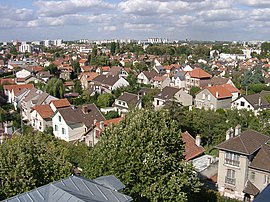Aulnay-sous-Bois
You can help expand this article with text translated from the corresponding article in French. (March 2012) Click [show] for important translation instructions.
|
Aulnay-sous-Bois | |
|---|---|
 Residential area as seen from the town hall's bell tower | |
| Country | France |
| Region | Île-de-France |
| Department | Seine-Saint-Denis |
| Arrondissement | Le Raincy |
| Canton | 2 cantons |
| Government | |
| • Mayor | Gérard Gaudron |
| Area 1 | 16.2 km2 (6.3 sq mi) |
| Population (2008) | 82,188 |
| • Density | 5,100/km2 (13,000/sq mi) |
| Time zone | UTC+01:00 (CET) |
| • Summer (DST) | UTC+02:00 (CEST) |
| INSEE/Postal code | 93005 /93600 |
| Elevation | 32 m (105 ft) |
| 1 French Land Register data, which excludes lakes, ponds, glaciers > 1 km2 (0.386 sq mi or 247 acres) and river estuaries. | |
Aulnay-sous-Bois (French pronunciation: [ɔlnɛsubwa]) is a commune in the northeastern suburbs of Paris, France. It is located 13.9 km (8.6 mi) from the centre of Paris.
In October and November 2005, it gained national and international attention as one of the focuses of the French suburb riots.
Name
The name Aulnay comes from Medieval Latin alnetum, meaning "alder grove", after the alder trees (French: aulnes) covering the territory of Aulnay-sous-Bois in ancient times.
Originally called Aulnay-lès-Bondy (meaning "Aulnay near Bondy"), the commune was renamed Aulnay-sous-Bois (meaning "Aulnay under wood") on 5 January 1903. The wood mentioned in the name is the ancient Bondy Forest which covered most of the area to the northeast of Paris.
Administration
Aulnay-sous-Bois is divided into two cantons:
- The canton of Aulnay sous Bois Nord (north): 55,298 inhabitants (69.1%);
- The canton of Aulnay sous Bois Sud (south): 24,723 inhabitants (30.9%).

Demographics
According to INSEE (2004), the average household income is €15,000. Much of the upper-middle class lives in the south of the town. The canton of Aulnay-Sud has a very different character from the canton of Aulnay-Nord, owing to differences in education and wages. For example, the average income in the south of the town is around €20,000 - €25,000 (2004), much higher than the national average of €15,000 (2004). Furthermore, the north (Aulnay-Nord) has a high number of HLM (public housing). There is even a political divide, with Aulnay-Nord Canton sending a Socialist representative (Gerard Segura) to the Council-General for the Seine-Saint-Denis Department, but Aulnay-Sud a conservative (Jacques Chaussat).
Immigration
| Born in metropolitan France | Born outside metropolitan France | |||
|---|---|---|---|---|
| 71.9% | 28.1% | |||
| Born in overseas France |
Born in foreign countries with French citizenship at birth1 | EU-15 immigrants2 | Non-EU-15 immigrants | |
| 2.9% | 2.6% | 3.4% | 19.2% | |
| 1 This group is made up largely of former French settlers, such as pieds-noirs in Northwest Africa, followed by former colonial citizens who had French citizenship at birth (such as was often the case for the native elite in French colonies), as well as to a lesser extent foreign-born children of French expatriates. A foreign country is understood as a country not part of France in 1999, so a person born for example in 1950 in Algeria, when Algeria was an integral part of France, is nonetheless listed as a person born in a foreign country in French statistics. 2 An immigrant is a person born in a foreign country not having French citizenship at birth. An immigrant may have acquired French citizenship since moving to France, but is still considered an immigrant in French statistics. On the other hand, persons born in France with foreign citizenship (the children of immigrants) are not listed as immigrants. | ||||
Transport
Aulnay-sous-Bois is served by Aulnay-sous-Bois station on Paris RER line B.
Automotive production
In May 1973 it was reported that the first Citroën DS had emerged from the production line at Citroën's new plant at Aulnay.[1] The plant has subsequently produced various Citroën and Peugeot models and has on occasion hit the headlines as a focus of industrial strife.
Aulnay is also the site of the subterranean Citroën repository of Citroën archives and 370 Citroën cars produced over the years. The repository, established in 2002,[2] is not open to the public, although members of Citroën enthusiasts' clubs and other important visitors are occasionally granted access to it.
See also
References
- ^ "News: The first Citroen DS has rolled off...". Autocar. 138 (nbr 4016): page 10. date 17 May 1973.
{{cite journal}}:|pages=has extra text (help); Check date values in:|date=(help) - ^ "Neues vom Auto: Heimat duer Citroen-Klassiker". Auto, Motor und Sport. 2001 Heft 26: Seite 16. date 12 December 2001.
{{cite journal}}: Check date values in:|date=(help)
External links


